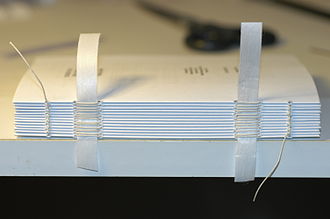Fitzbund

Fitzbund (Upper Saxon Fitz = bundle , yarn ) is a term from manual binding . On the one hand, it refers to the marking below the head or above the foot of a book block to be bound, which indicates the point at which the stitching thread leaves one layer that has already been bound and is inserted into the next, and on the other hand also the loop knot with which the bookbinder is knotted At this mark, tie the thread with the Fitzbund of the previous layer and in this way create a series of strengthening chain stitches .
The Fitzbund marks the turning point of the thread when basting the book block. The execution of the activity itself is called “enticing” and is linguistically derived from “knotting” or “tying together”. In contrast to real frets, fretted frets can hardly be seen later, as they are only slightly bulky, like sawn-in frets.
The Fitzbund came about when book blocks began to be trimmed towards the end of the 14th century. Before that, the stitching thread was led to the edge of the head and foot of a layer, where it was entwined and thus created the pricked headband .
But even if the Fitzbund is no longer carried over the entire height of the layers , the following also applies here: the closer it comes to the cut edges , the stronger the connection between the layers.
literature
- Dag-Ernst Petersen: Fitzbund. In: Severin Corsten (Ed.): Lexicon of the entire book system. Volume 2. Buck - Foster. Hiersemann, Stuttgart 1989, ISBN 3-7772-8527-7 .
- Hellmuth Helwig: Handbook of the binding customer. Volume 1: The development of cover decoration, its purpose, evaluation and literature. Preserving and cataloging. The single-tape hobby over the centuries. Maximilian Society, Hamburg 1953.

